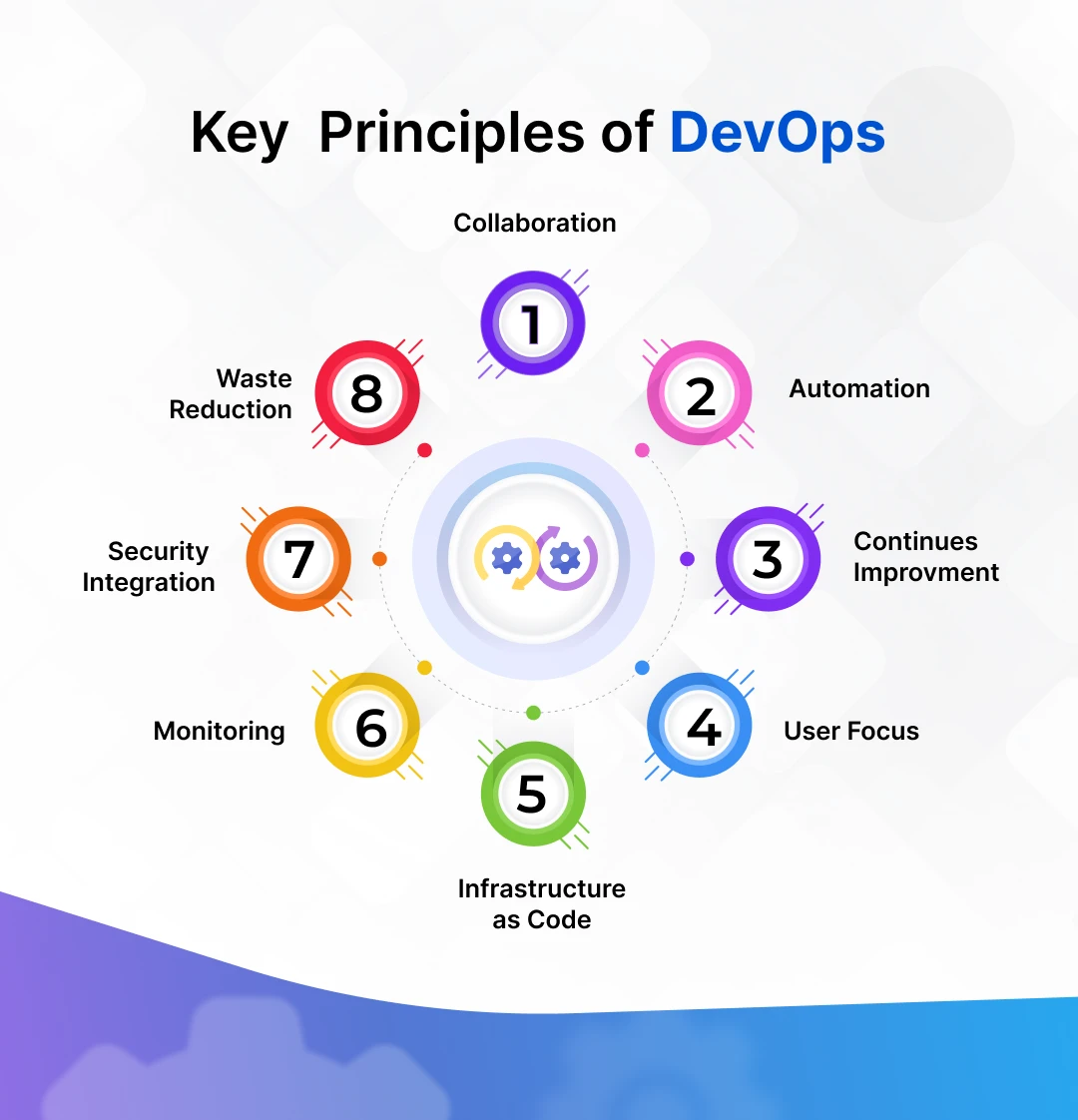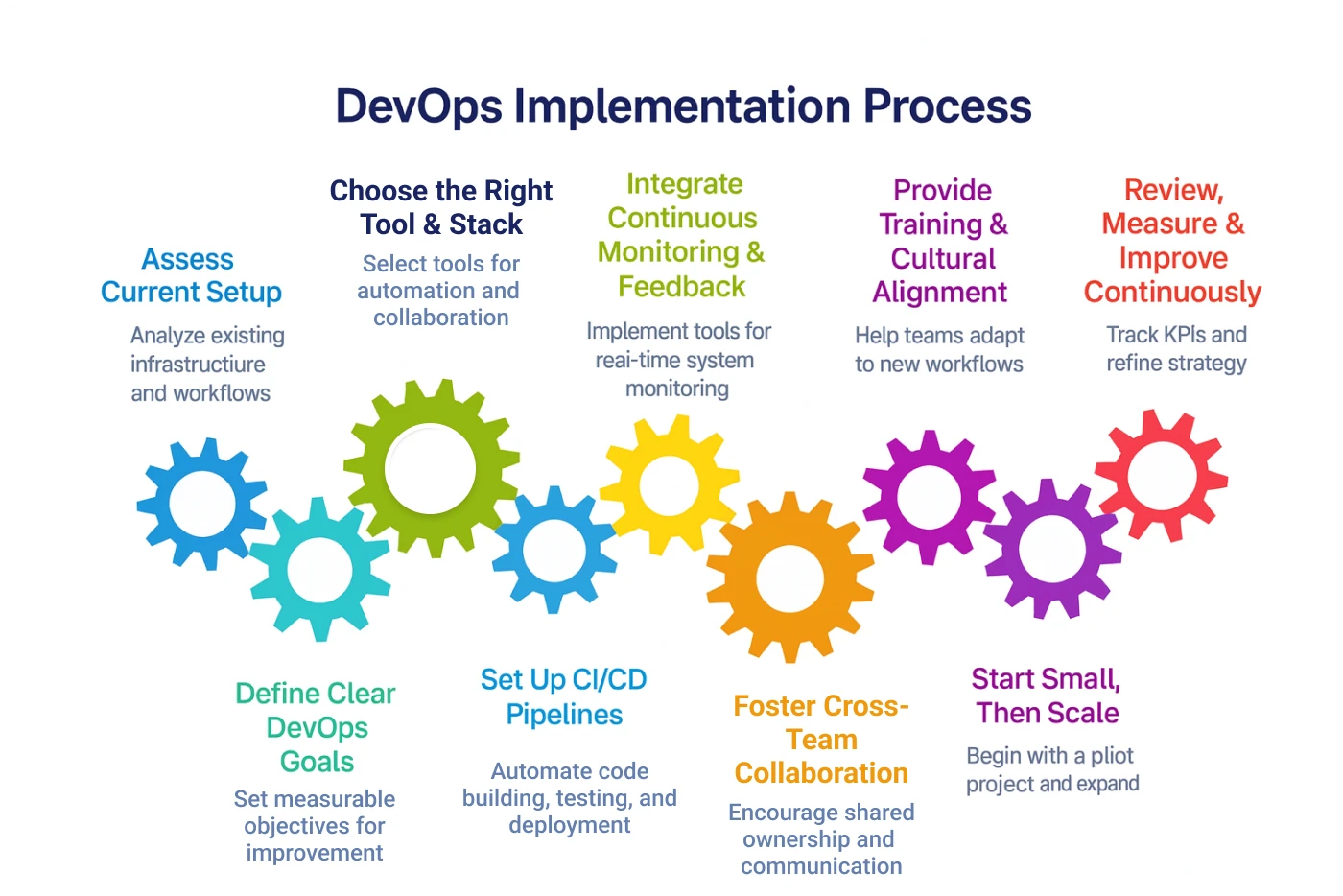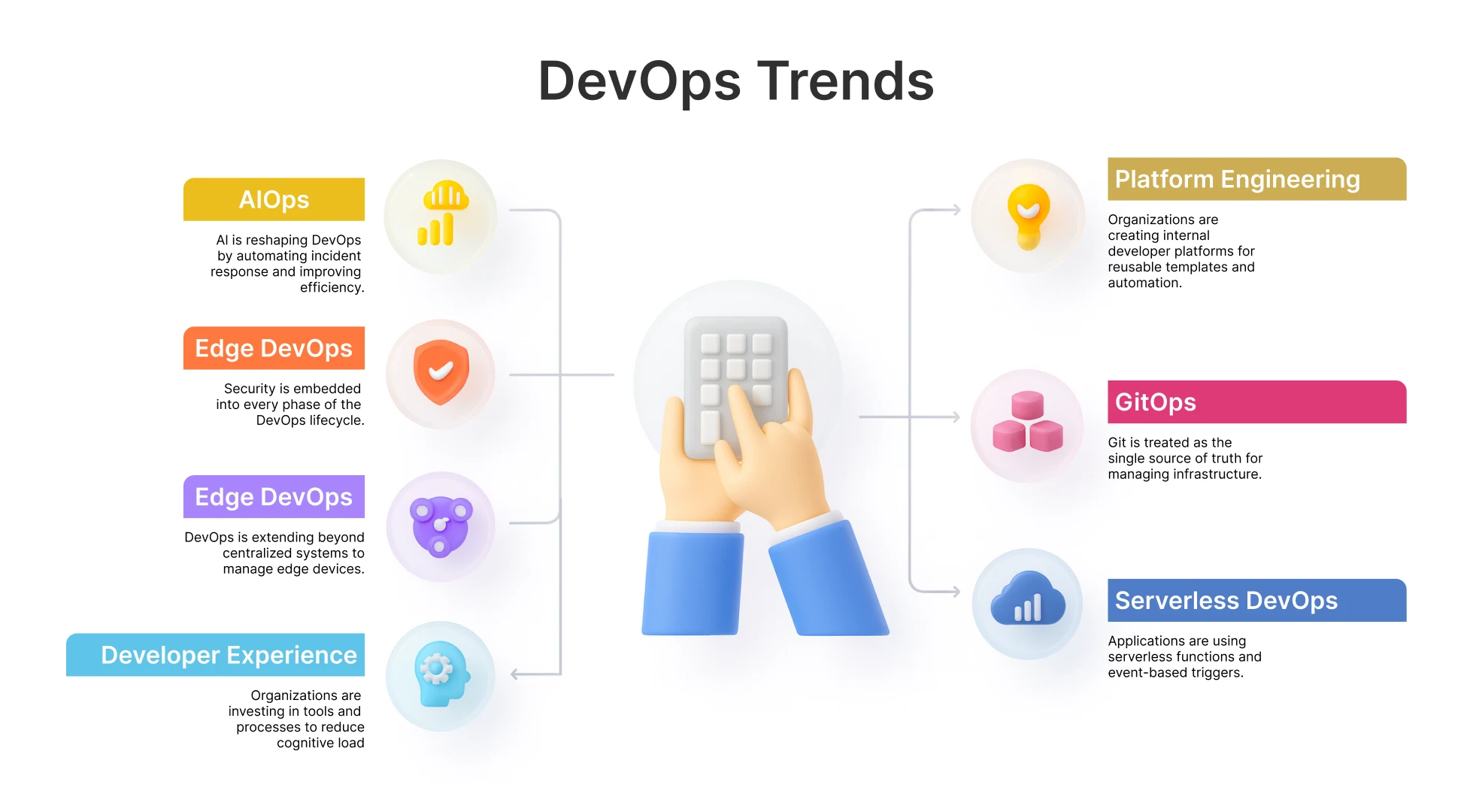DevOps Guide
Summary
This guide explores DevOps from foundational principles to real-world execution. It outlines key benefits like faster releases and improved collaboration, breaks down implementation steps, and highlights essential tools across CI/CD, monitoring, and automation. It also covers common challenges, success metrics, future trends, and showcases Ksolves’ role in solving complex DevOps issues.
Introduction
DevOps is a set of practices that brings together software development (Dev) and IT operations (Ops) to shorten the development lifecycle and deliver high-quality software continuously.
It encourages collaboration, automation, and real-time monitoring. This ensures that code moves quickly from development to deployment with minimal risk and maximum reliability.
Adopting DevOps can be challenging without the right strategy and expertise. Consulting and support services help businesses align DevOps with their goals, implement best practices, choose the right tools, and navigate cultural changes.
For growing teams or complex infrastructures, expert guidance leads to faster deployments, better performance, and long-term scalability. In this guide, we’ll cover the core principles of DevOps, key benefits, common challenges, essential tools, and how consulting services can accelerate your DevOps journey.
What are the Benefits of DevOps for Businesses
DevOps offers tangible advantages that go beyond faster deployments. It transforms how teams collaborate, innovate, and respond to change. One of the most significant benefits is faster time-to-market. By automating deployments and streamlining workflows, teams can release new features and fixes more frequently and with greater confidence.
Improved collaboration is another key advantage, as DevOps breaks down silos between developers, QA, and operations, fostering a culture of shared ownership and better communication. This collaboration, in turn, leads to higher software quality. Continuous integration and automated testing help catch bugs early in the development cycle, resulting in more stable releases and enhanced user experiences.
With automated and repeatable processes in place, the success rate of deployments increases significantly. The risk of human error is reduced, leading to fewer rollbacks, service disruptions, or production outages. Finally, DevOps contributes to cost optimization. By reducing manual interventions and minimizing downtime, businesses can lower operational costs and make more efficient use of their infrastructure and development resources.
Key DevOps Principles Every Company Should Follow
DevOps is all about how teams work together to build and deliver better software, faster. Here are some key principles to keep in mind:
-
-
Collaboration Between Development and Operations
When developers and operations teams work closely, things move faster, and problems get solved quicker. Everyone shares responsibility for the final product.
-
Automation-First Mindset
DevOps automation saves time and reduces mistakes. From testing to deployments, letting tools handle repetitive tasks helps your team focus on what really matters.
-
Continuous Improvement
DevOps is all about small, regular improvements. Even tiny tweaks to your process can lead to big wins over time.
-
Think About the User
Always build with the customer in mind. Fast feedback loops help you quickly adjust based on user needs or product issues.
-
Infrastructure as Code (IaC)
Instead of setting up servers manually, treat infrastructure like software. This makes it easy to copy, update, or fix your environment.
-
Monitor Everything
Use tools to track how your app and systems are performing. The sooner you catch an issue, the easier it is to fix.
-
Build Security Into the Process
Security shouldn’t be an afterthought. Bring it into your workflow from day one to avoid surprises later.
-
Cut Out the Waste
Avoid doing work that doesn’t add value, like writing unused code or waiting on long approvals. DevOps helps teams stay focused and efficient.
-
DevOps Implementation Roadmap
Implementing DevOps goes beyond choosing the right tools. It requires a fundamental cultural and technical transformation. Here’s a practical, step-by-step process to help your team begin the journey and achieve long-term success.
-
Assess Your Current Setup
Begin by analyzing your existing infrastructure, workflows, and team structure. Identify manual tasks, communication gaps, and inefficiencies. This step helps create a realistic baseline.
-
Define Clear DevOps Goals
Set measurable objectives based on your business needs, whether it’s faster release cycles, fewer outages, or improved team productivity. These goals will guide your entire DevOps journey.
-
Choose the Right Tools & Stack
Pick tools that support automation, integration, and collaboration. These include version control (like Git), CI/CD tools (like Jenkins or GitHub Actions), and monitoring platforms.
-
Set Up CI/CD Pipelines
Automate the process of building, testing, and deploying code. This reduces manual errors, speeds up releases, and improves consistency across environments.
-
Integrate Continuous Monitoring & Feedback
Add tools for real-time system monitoring, log tracking, and user feedback. This ensures issues are caught early and performance stays strong over time.
-
Foster Cross-Team Collaboration
Break down silos between development, operations, QA, and security. Encourage shared ownership of applications and infrastructure through regular communication and transparency.
-
Provide Training & Cultural Alignment
Help your team adapt to new workflows through training sessions, workshops, and mentoring. Emphasize the “DevOps mindset” of shared responsibility and continuous improvement.
-
Start Small, Then Scale
Begin with a pilot project or specific app. Once successful, apply those learnings to other areas of the business.
-
Review, Measure & Improve Continuously
Track KPIs like deployment frequency, lead time, and incident recovery. Use these metrics to refine your DevOps strategy regularly.
Essential DevOps Tools and Technologies
A successful DevOps strategy relies on the right DevOps tools and technologies across each stage of the development and operations pipeline. Here are the core categories and top tools every DevOps team should know:
| Category | Purpose | Popular Tools |
| Version Control Systems (VCS) | Track code changes, enable rollback, and support collaboration. | – Git – GitHub – GitLab – Bitbucket |
| CI/CD (Continuous Integration & Delivery) | Automate testing, integration, and deployments. | – Jenkins – CircleCI – GitHub Actions – GitLab CI/CD – Argo CD – Spinnaker |
| Containerization & Orchestration | Package and manage applications across environments. | – Docker – Kubernetes – Helm |
| Infrastructure as Code (IaC) | Provision and manage infrastructure using code. | – Terraform – AWS CloudFormation – Pulumi |
| Configuration Management | Automate consistent infrastructure setup and application deployment. | – Ansible – Chef – Puppet – SaltStack |
| Monitoring & Logging | Ensure system visibility, detect issues, and analyze logs. | – Prometheus – Grafana – ELK Stack (Elasticsearch, Logstash, Kibana) – Datadog – New Relic – Splunk |
| Security & Compliance (DevSecOps) | Embed security into DevOps workflows. | – Snyk – Aqua Security – SonarQube – HashiCorp Vault |
| Testing & Quality Assurance | Automate testing to ensure quality and reliability. | – Selenium – Cypress – JUnit – TestNG – Postman – Newman |
| Collaboration & Project Management | Improve team communication and project tracking. | – Slack – Microsoft Teams – Jira – Trello – Azure Boards |
Read More:
How to Measure DevOps Success (KPIs & Metrics)
Tracking the right KPIs (Key Performance Indicators) helps you understand how well your DevOps practices are working across speed, quality, and team performance. Here are some essential metrics to monitor:
1. Deployment Frequency
- What it means: How often your team deploys code to production (daily, weekly, monthly).
- Why it matters: Frequent deployments indicate agility and the ability to deliver features, bug fixes, or updates quickly to end users.
2. Lead Time for Changes
- What it means: The time taken from committing code to successfully deploying it.
- Why it matters: A shorter lead time means your team can respond to business needs faster and reduce time-to-market for new features.
3. Mean Time to Recovery (MTTR)
- What it means: The average time it takes to recover from an incident, system failure, or production bug.
- Why it matters: A low MTTR shows that your systems are resilient and your team is prepared to act quickly during outages.
4. Change Failure Rate
- What it means: The percentage of deployments that cause a failure or require rollback.
- Why it matters: This shows the stability of your releases. A high failure rate suggests the need for better testing or more reliable processes.
5. Automated Test Coverage
- What it means: The percentage of your codebase covered by automated tests.
- Why it matters: Higher test coverage reduces the chances of bugs slipping into production and speeds up the release cycle by enabling continuous testing.
6. Customer Ticket Volume / Incident Rate
- What it means: The number of user-reported issues or support tickets after deployments.
- Why it matters: A drop in ticket volume over time is a good sign that your deployments are stable and users are experiencing fewer problems.
7. Infrastructure Provisioning Time
- What it means: The time it takes to set up infrastructure using scripts or automation tools.
- Why it matters: Faster provisioning means your team can scale, test, or recover systems quickly without delays or manual intervention.
8. Deployment Success Rate
- What it means: The ratio of successful deployments versus failed ones.
- Why it matters: A consistently high success rate suggests reliable CI/CD pipelines and well-tested code.
9. Cycle Time
- What it means: The total time taken to complete a task or feature—from planning to production.
- Why it matters: It gives visibility into process bottlenecks and helps improve delivery predictability.
10. Team Satisfaction & Collaboration
- What it means: Internal feedback about workflows, tool usability, and cross-team collaboration.
- Why it matters: Happier, better-aligned teams are more productive and contribute to healthier DevOps culture and outcomes.
Common DevOps Challenges & How to Overcome Them
While DevOps promises faster delivery, better collaboration, and higher quality, its adoption often comes with practical hurdles. Let’s explore the most common challenges teams face and how to effectively overcome them.
1. Cultural Resistance
The challenge: DevOps requires breaking down silos between development, operations, QA, and security teams. But long-standing habits and fear of change can slow adoption.
How to overcome it:
- Promote a collaborative, fail-fast mindset through workshops and internal champions.
- Start small with pilot teams to demonstrate success.
- Encourage transparency and shared responsibility using agile ceremonies and feedback loops.
2. Toolchain Complexity
The challenge: Managing multiple tools (CI/CD, monitoring, containers, etc.) from different vendors can lead to integration headaches and inefficiencies.
How to overcome it:
- Use end-to-end platforms or well-integrated toolchains like GitHub + Actions + Kubernetes.
- Standardize tool usage across teams.
- Automate integration using Infrastructure as Code (IaC) and CI/CD pipelines.
3. Security Concerns (DevSecOps)
The challenge: Security is often treated as an afterthought, leading to vulnerabilities in fast-paced DevOps environments.
How to overcome it:
- Embed security checks in the CI/CD pipeline (e.g., static code analysis, container scanning).
- Adopt “shift-left” security by involving security teams early in development.
- Use automated policy enforcement and vulnerability monitoring tools.
4. Lack of Skilled Talent
The challenge: DevOps demands expertise across cloud, automation, scripting, testing, and infrastructure, but such talent is scarce.
How to overcome it:
- Invest in training and certifications (AWS, Azure, Kubernetes, GitOps).
- Pair junior developers with experienced DevOps engineers through mentorship.
- Encourage cross-functional knowledge sharing.
5. Inconsistent Environments
The challenge: Development, staging, and production environments often behave differently, leading to deployment issues.
How to overcome it:
- Use containers (like Docker) and Infrastructure as Code (like Terraform) to standardize environments.
- Adopt configuration management tools like Ansible or Puppet.
6. Monitoring & Observability Gaps
The challenge: Without proper monitoring, it’s hard to detect issues, analyze root causes, or ensure reliability.
How to overcome it:
- Implement centralized logging, real-time monitoring, and alerting (e.g., Prometheus, Grafana, ELK Stack).
- Use observability tools to trace application behavior end-to-end.
- Set clear SLAs and error budgets.
7. Tool Overload Without Strategy
The challenge: Adopting too many tools without a defined strategy leads to confusion and overhead.
How to overcome it:
- Prioritize tools that align with business goals.
- Periodically review and audit the toolchain for redundancy.
- Define a DevOps governance model.
[Also Read: Common DevOps Misconceptions You Should Stop Believing]
Case Studies: How Ksolves Drives DevOps Success
At Ksolves, we’ve helped enterprises overcome DevOps bottlenecks with tailored automation, GitOps, and cloud-native strategies. These success stories showcase our ability to solve complex infrastructure challenges and accelerate delivery pipelines with measurable results.
Strengthening Security with Automated Lynis Audits
Client Challenge: The client needed to enhance cybersecurity across Linux systems without overloading their DevOps team.
Ksolves Solution: We automated Lynis audits through GitLab CI/CD pipelines, enabling continuous security checks integrated with alerting systems.
Results:
- 80% reduction in manual audit time
- Real-time vulnerability reporting
- Stronger compliance posture
Accelerating Kubernetes Deployments via GitOps & ArgoCD
Client Challenge: Multi-cluster Kubernetes management lacked consistency and automation.
Ksolves Solution: Using ArgoCD and GitOps practices, we streamlined deployments with automated environment sync, version control, and drift detection.
Results:
- 70% faster deployment cycles
- Error-free releases and instant rollback support
- Full visibility and control over all clusters
The Future of DevOps: Key Trends to Watch
As technology evolves, so does DevOps. What began as a method to bridge development and operations is now expanding into an intelligent, automated, and security-first discipline. Here are the key trends shaping the future of DevOps:
1. AI and ML in DevOps (AIOps)
AI is reshaping how DevOps teams detect issues, analyze logs, and automate incident response. Intelligent monitoring and predictive alerts allow teams to act before problems escalate. In high-scale environments, AIOps reduces downtime, boosts efficiency, and supports 24×7 reliability with minimal human intervention.
2. Platform Engineering for Scalable Self-Service
Rather than letting every team reinvent the wheel, organizations are creating internal developer platforms (IDPs) that offer reusable templates, pre-approved tech stacks, and built-in automation. This standardization improves developer productivity while ensuring governance, consistency, and faster onboarding.
3. DevSecOps Becomes the Default
With rising cyber threats and strict compliance mandates, security is now embedded into every phase of the DevOps lifecycle. From automated vulnerability scans in CI pipelines to policy enforcement in infrastructure code, DevSecOps shifts security left and ensures applications are safe by design.
4. GitOps Adoption Beyond Kubernetes
GitOps principles, treating Git as the single source of truth, are being adopted for managing infrastructure, cloud services, and multi-cluster environments. As automation and traceability become crucial, GitOps is enabling faster rollbacks, clearer audits, and more consistent delivery across hybrid setups.
5. Edge DevOps for Distributed Systems
As IoT and edge computing rise, DevOps is extending beyond centralized systems. Teams are building pipelines that deliver updates to edge devices, manage limited connectivity, and maintain security at distributed endpoints. Industries like manufacturing and logistics are already adopting edge-first strategies.
6. Event-Driven and Serverless DevOps
Modern applications are increasingly using serverless functions and event-based triggers. This approach reduces infrastructure management and accelerates time to deployment. It also simplifies CI/CD workflows by executing actions only when needed. It is ideal for microservices and burst workloads.
7. Focus on Developer Experience (DevEx)
High-performing organizations are investing in tools, processes, and environments that reduce cognitive load on developers. From instant feedback loops and auto-provisioned test environments to clear documentation and internal platforms, DevEx is emerging as a strategic lever to speed delivery and retain talent.
Key Takeaways
| Takeaway | Summary |
| DevOps is more than tools | It’s a cultural and workflow shift that promotes collaboration, automation, and agility. |
| Consulting accelerates success | Expert DevOps consulting helps align strategies, avoid pitfalls, and scale faster. |
| Tangible business impact | Faster releases, better quality, cost savings, and scalable delivery pipelines. |
| Core principles matter | Follow automation-first, continuous improvement, IaC, monitoring, and shift-left security. |
| Start small, scale smart | Begin with a pilot project, measure results, then expand across teams and environments. |
| Use a standardized toolchain | Choose integrated tools across CI/CD, containers, monitoring, IaC, and testing. |
| Embed security early (DevSecOps) | Integrate vulnerability scanning, secret management, and policy enforcement from the start. |
| Challenges are common but solvable | Issues like tool overload, skill gaps, or resistance need strategy, training, and governance. |
| Real-world success with Ksolves | Case studies show improved deployment cycles, security posture, and operational visibility. |
| Future of DevOps is intelligent & developer-first | Trends like AIOps, GitOps, and platform engineering are redefining modern DevOps practices. |
Conclusion & Next Steps
DevOps is no longer just a competitive edge; it’s a fundamental requirement for modern software delivery. But adopting it effectively takes more than implementing the right tools. It calls for a cultural transformation, strategic alignment with business objectives, and experienced guidance to navigate the complexities.
Whether your goal is to streamline legacy pipelines, enhance scalability, or embed security from the ground up, partnering with the right DevOps consultants can help you deliver high-quality software faster, with greater reliability and agility.
Ready to Get Started?
Transforming your software delivery with DevOps starts with the right partner. At Ksolves, we bring deep expertise in DevOps consulting, CI/CD pipeline optimization, infrastructure automation, Kubernetes deployments, cloud-native practices, and more.
Our certified professionals work closely with your team to tailor solutions that align with your goals, whether you’re just beginning your DevOps journey or scaling enterprise-wide practices.
Let’s build faster, safer, and smarter together.
Contact Ksolves today at sales@ksolves.com to kickstart your DevOps transformation.
FAQs
1. What is DevOps in simple terms?
DevOps is a way of working where software developers and IT operations teams collaborate, automate workflows, and deliver software quickly, safely, and efficiently.
2. Why should a company invest in DevOps consulting?
DevOps consulting helps businesses avoid costly mistakes, choose the right tools, align DevOps with business goals, and build a sustainable, scalable delivery model.
3. How long does DevOps implementation take?
It depends on your organization’s size, current maturity, and goals. A pilot project can start showing results in weeks, while full transformation may take several months.
4. What tools are essential for a DevOps team?
Core tools include Git (version control), Jenkins/GitHub Actions (CI/CD), Docker & Kubernetes (containers), Terraform (IaC), and Prometheus/Grafana (monitoring).
5. How do we measure DevOps success?
Track KPIs like deployment frequency, lead time for changes, mean time to recovery, change failure rate, test coverage, and team satisfaction.
6. What are the main challenges in DevOps adoption?
Common hurdles include resistance to cultural change, toolchain complexity, lack of skilled personnel, inconsistent environments, and inadequate security practices.
7. Is DevOps only for large enterprises?
No. DevOps benefits teams of all sizes—from startups seeking agility to enterprises aiming to scale and modernize their software delivery.






